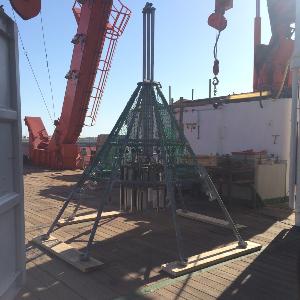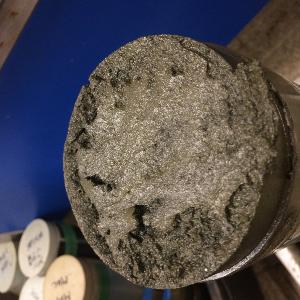Geomicrobiology: the habitat of the first animals
20 Feb 2025
The first animals lived on the ocean floor. LMU researchers have found that microbial metabolic processes and marine material cycles played a key role in their early evolution.
20 Feb 2025
The first animals lived on the ocean floor. LMU researchers have found that microbial metabolic processes and marine material cycles played a key role in their early evolution.

Mission at the seafloor: The "multi corer" is used to multiple sample sediment cores at the same time. | © William Orsi
The earliest known animal fossils are almost 600 million years old. They belong to an assemblage of fossil organisms known as the Ediacaran biota, large soft-bodied creatures that lived on the seafloor. Originally dominated by bacteria and other single-celled microorganisms without a nucleus, these seabed ecosystems started becoming increasingly complex, and more like extant habitats, around 820 to 635 million years ago. At this time, red and green algae began proliferating in the surface ocean, a transition dubbed the ‘Rise of Algae’ by Earth scientists. When these eukaryotic microalgae fell to the seabed, they delivered both energy and nutrients to deep-sea ecosystems.
LMU geomicrobiologists have now managed to reconstruct how early protists – or single-celled eukaryotes – could have served as important links in the food webs that eventually supported the earliest animals. “We found a mechanism that explains the connections between the evolution of the algae, the metabolism of the protists on the seabed, and the origins of animals,” says Professor William Orsi from the Department of Earth and Environmental Sciences at LMU. This was a development that took place over very long spans of time from a human perspective. “We’re talking about hundreds of millions of years between the start of the ‘Rise of Algae’ and the start of animal life. This is a vast duration of time, and data from this phase of Earth history are scarce,” says Dr. Daniel Mills, lead author of the study, which has now been published in the journal Science Advances. Despite these constraints, the results suggest how protists could have altered marine food webs in a way that set the stage for early animal evolution.

Top of a sediment core, the green color is unique to the Namibian sediments and is due to a high amount of iron minerals. | © William Orsi
The team led by Orsi and Mills discovered that protists from modern marine sediments increase their growth and metabolic activity when supplied with algal biomass under anoxic conditions. The researchers also identified the underlying metabolic mechanisms, which are based on modified gene expression in favor of genes that, among other things, are involved in the active absorption of particles into the cell (phagocytosis) and in energy metabolism under anaerobic conditions. “The results show that phagocytosis actually works more efficiently even under such anoxic conditions, than we originally expected,” says Orsi.
Using genetic analyses and estimates based on mutation rates (“molecular clock”) and fossils, scientists predict that many groups of extant protists were present during the ‘Rise of Algae.’ In ancient marine sediments, which ranged from oxygen-poor to outright anoxic, these protists subsisted on the biomass of microalgae abundantly dropping down from the upper water layers. In doing so, these protists helped transform deep-sea ecosystems by promoting the transport of carbon, nutrients, and energy to larger organisms at higher trophic levels – including, eventually, the first animals.
It is still unclear how the first animals ate. Could the earliest members of the Ediacara biota eat protists living on the seafloor? If so, which ones? “As things stand, we have to speculate about the details here,” says Mills. “We also need to test how protists living at the seafloor respond to different types of algae and bacteria, both in the presence and absence of oxygen. The first animals were likely adapted to low oxygen concentrations.”
This research not only enriches our understanding of ecosystems at the dawn of animal life, but also provides important insights into modern marine ecology. “Our results also show how algae sinking from the sea surface encourage the growth of protists living in the sediments of the Benguela Upwelling System,” says Mills. This region off the coast of southwestern Africa, where the researchers took samples in the course of their study, is one of the most productive ecosystems in the world, supporting many key fisheries.
Daniel B. Mills, Aurèle Vuillemin et al.: The Rise of Algae promoted eukaryote predation in the Neoproterozoic benthos. Science Advances, 2025